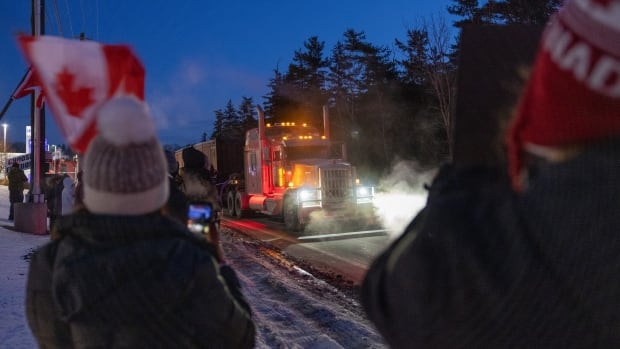
In late January, as convoys of flag-bedecked tractor-trailers, RVs and pickup trucks streamed toward the capital from practically every corner of Canada, Charles Bordeleau watched with professional interest but not much concern.
As its former chief, Bordeleau knew the Ottawa Police Service (OPS) was deeply experienced — perhaps more experienced than any other law enforcement agency in the country — at managing protests of all shapes and sizes.
As well, police had ample warning about what was heading their way. They could literally watch the western convoy coming from 4,000 kilometres away, and were receiving regular intelligence updates as it approached the city.
These groups will be back. We just don’t know what shape it will take.– Jeffrey Monaghan, Carleton University
“I had confidence that things would be handled very well,” recalled Bordeleau, who commanded the force from 2012 to 2019 and remains a resident of Ottawa.
That confidence quickly evaporated as the convoys converged on Ottawa on Jan. 28 and 29. Ottawa police had provided organizers with route maps to Wellington Street, but the sheer volume of trucks pouring off Highway 417 and heading for Parliament Hill soon rendered the traffic plan useless.
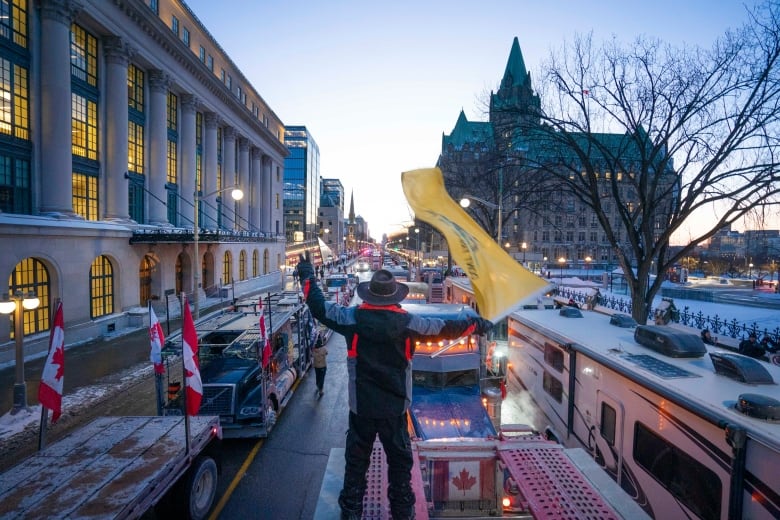
Wellington the ‘prize pig’
Wellington Street, which former Ottawa mayor Jim Watson would later refer to as the “prize pig” for the anti-vaccine-mandate, anti-government protesters, filled up fast. The overflow soon began clogging neighbouring streets, including residential areas.
Most of the police intelligence gathered in the days leading up to the protesters’ arrival indicated they would likely be gone by the following Monday, but it soon became clear to Bordeleau that many were digging in.
At least one pickup truck had its wheels removed, in an unmistakable signal that its owner wasn’t planning to go anywhere.
“I became concerned when I saw that, and I got the clear sense that first day that they were here for a longer time than just the weekend,” Bordeleau recalled. “That’s when my red flags went up saying, OK, this is bigger potentially than what was expected.”
The convoy protest that rolled into Ottawa that weekend, and which turned into a three-week occupation of the city’s downtown, was not only bigger than what most observers had expected. It was fundamentally different.
By the end of that first weekend, the protesters had established a virtual fortress of heavy vehicles within a few hundred metres of the Peace Tower. They’d also taken over a nearby park and established supply lines for food and fuel with the efficiency of a military operation.
With his experienced eye, Bordeleau quickly realized Ottawa police weren’t prepared to deal with these new tactics.
“Their plans did not include contingencies around, what if they stay? What if a large number of people stay? [That’s when] it became apparent to me that they were at a loss.”
A ‘paradigm-shifting event’
The ultimate aim of the Public Order Emergency Commission, where six weeks of witness testimony drew to a close yesterday with an appearance by Prime Minister Justin Trudeau, is to determine whether the federal government was justified in invoking the Emergencies Act on Valentine’s Day to help end the occupation in Ottawa and similar border blockades elsewhere.
But the hearings have been just as much an appraisal — and at times an indictment — of the police response, particularly that of the OPS which, with Bordeleau’s successor Peter Sloly at the helm, seemed overwhelmed and under-prepared from the outset.
Midway through the first week of the occupation, Sloly announced that “there may not be a police solution to this demonstration,” leaving the public, politicians and other police agencies to guess at what he meant.
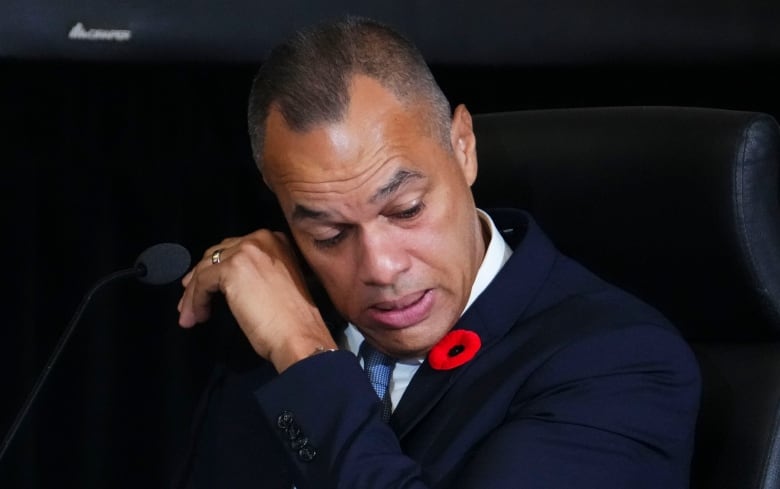
According to his later testimony, Sloly had already reached the conclusion that Ottawa police lacked the resources to evict the protesters, who were becoming further and further entrenched in the city’s downtown and at a satellite encampment on Coventry Road.
Less than two weeks later, the day after the Emergencies Act was brought into force, Sloly resigned. He would ultimately bear much of the blame for the flaccid police response.
When he appeared before the commission last month, Sloly — who’d had nine months to contemplate the events — described the convoy protest in Ottawa as a “paradigm-shifting event.”
The protesters hadn’t just changed the rule book. They had tossed it out the window and run it over with an 18-wheeler.
Now, with at least one of the groups involved in the occupation threatening to return in February, it’s time to consider what police learned, how they’re likely to respond to a similar influx of protesters, and whether they’re prepared for the possibility that tactics could change again, shifting the paradigm once more.
Allowing trucks downtown ‘a big misstep’
According to Bordeleau, the first blunder — or at least the first operational error, as opposed to an intelligence gap — was allowing hundreds, perhaps thousands of vehicles to crowd into the downtown at once.
“They should not have allowed those vehicles into the downtown core to the extent that they did. That was a big misstep,” Bordeleau said.
Sloly told the commission he was concerned about infringing on the protesters’ charter rights by stopping vehicles short of their destination, but others have pointed out that those rights apply to people, not trucks.
The Ottawa police traffic plan devised in the days leading up to the convoy’s arrival was focused on funnelling protest vehicles toward Wellington Street, with “staging areas” along the Sir John A. Macdonald and Sir George-Étienne Cartier parkways, depending on their approach.
Kent Street was offered as another route in, and vehicles crossing the Ottawa River from Quebec were directed to follow King Edward Avenue to Rideau Street. Elgin Street, Laurier and Nicholas avenues were identified as emergency routes.
With few road closures and no police escorts, however, the traffic plan quickly fell apart as most protesters jockeyed for positions as close to Parliament Hill as they could get.
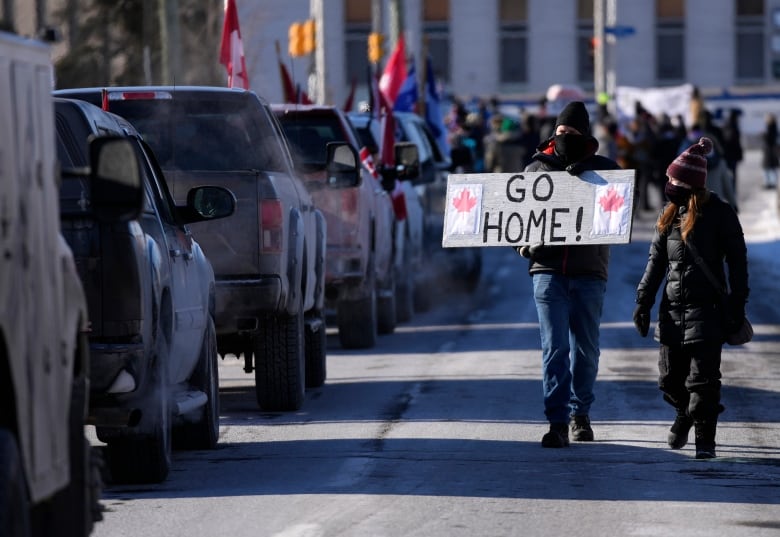
Greg Brown, who spent 35 years with the OPS and retired as a detective sergeant before embarking on an academic career and obtaining a PhD in sociology, believes police had the authority to stop the trucks before they reached the parliamentary precinct.
At the very least, police could have established a no-go zone for vehicles.
“Certainly in my analysis of the situation, laws exist to prevent that,” Brown said.
“If you were to drive an 18-wheel transport truck today and park it on Queen Street and sit there and blast your horn and hang a protest sign, you’d probably be arrested and towed within five minutes. So I’m not quite sure what the police were thinking when they saw the large amount of trucks descend into the urban core … but certainly there’s laws in effect that could have permitted them to be removed immediately.”
Rolling Thunder and the lessons learned
By late April, when the “Rolling Thunder” rally rumbled into town, it was evident that police had indeed learned some valuable lessons about quick, decisive enforcement.
Rolling Thunder, which was billed as a motorcycle rally, bore many similarities to the convoy protest in terms of both the protesters’ grievances and their aggressive tactics. But when some tried to park their vehicles for an extended stay on Rideau Street, they were quickly surrounded by police.
Due to an escalation of crowd aggression, officers are deployed in helmets and shields for their protection in order to clear the crowd at Rideau and Sussex.
—@OttawaPolice
Those who didn’t move were arrested and their vehicles were towed. They were denied any chance to settle in, as they had been allowed to do barely a month earlier.
“I think they proved with Rolling Thunder that they know the mistakes that were done, and this requires a different approach, and they cannot allow them to entrench themselves,” Bordeleau said.
“Impound the trucks, arrest the people, impound the trucks, arrest the people,” Brown said. “Given the debacle that happened, I think that would be the lesson learned, is you’ve got to address that immediately.”
Tow trucks in action now. Many people shouting at police. <a href=”https://t.co/2Bmy7cGTj5″>pic.twitter.com/2Bmy7cGTj5</a>
—@DCFraser
Brown believes such swift, decisive police response can also deter others from driving in to join the party.
“They’re hearing within 20 minutes of you arriving you’re going to be in jail and your truck’s going to be impounded. They’re going to do a U-turn and head back to where they’re coming from,” he said.
Time for permanent closure?
Other police agencies have demonstrated that they, too, learned from the mistakes made in Ottawa last winter.
While similar convoy protests in Toronto and Quebec City lacked the sheer numbers seen in the nation’s capital, police in those cities were able to avoid similar outcomes largely by preventing road access to their respective legislatures.
In Ottawa, Wellington Street still remains closed to traffic between Elgin and Bank streets, and Brown is among the many who believe it should stay that way.
“I think a permanent barrier to the key parliamentary precinct is something long overdue, not just in terms of responding to protest,” he said.
On Canada Day, when hundreds of anti-vaccine-mandate protesters returned to Wellington Street, they did so on foot, and police handled the demonstration with relative ease.
“You need to have Parliament Hill as a protest space for people, not for trucks,” said Jeffrey Monaghan, an associate professor at Carleton University’s Institute of Criminology and Criminal Justice who studies protest policing.
“I don’t think we need to militarize protest policing. What we need to do is control access to Parliament.”
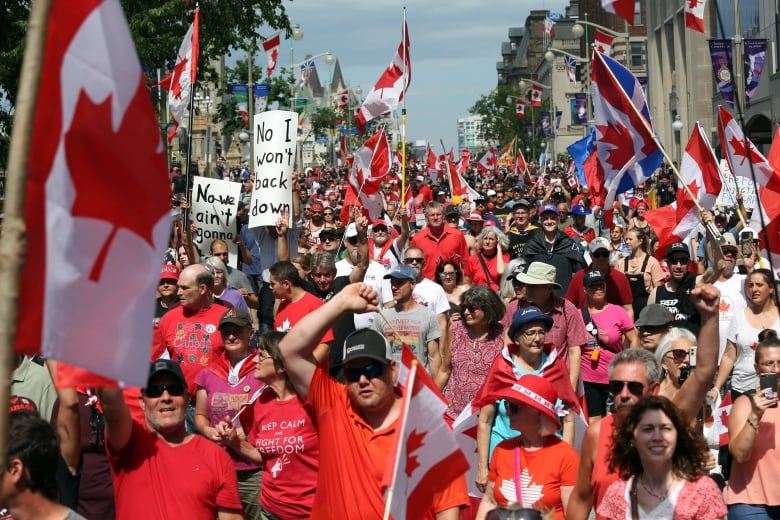
Flawed intelligence
Monaghan agrees that the initial decision by police to allow all those trucks free access to the parliamentary precinct was a major blunder, but he also believes police were operating with flawed intelligence.
“It was very clear these were folks who had serious grievances and were going to be staying,” he said. “So yeah, it was a categorical failure. And everyone who testified from the Ottawa police has really been very reluctant in acknowledging that as a significant, significant failure.”
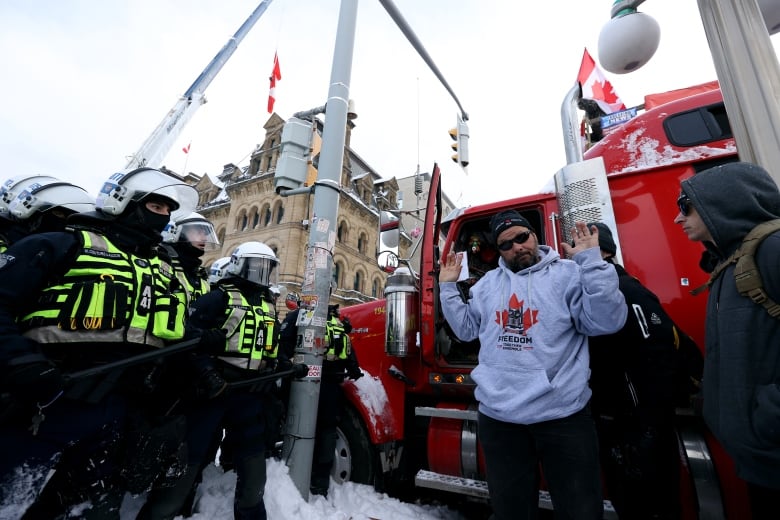
Among the assessments Ottawa police received and relied upon to plan their response last winter was a controversial document produced by their own security intelligence section — one Monaghan describes as “bananas.”
“It refused to actually recognize that a bunch of these groups … engage in all kinds of vigilante justice,” he said. “They are not predictable actors. They think they’re morally righteous, they’re going to be aggressive and assertive, they’re not going to [follow] a typical civil disobedience playbook. They’re outside the playbook.
“Anyone who’s looking at these groups and the people leading these things saw this coming.”
(Unrelated social media posts by the report’s author are now under review by the police service’s professional standards branch.)
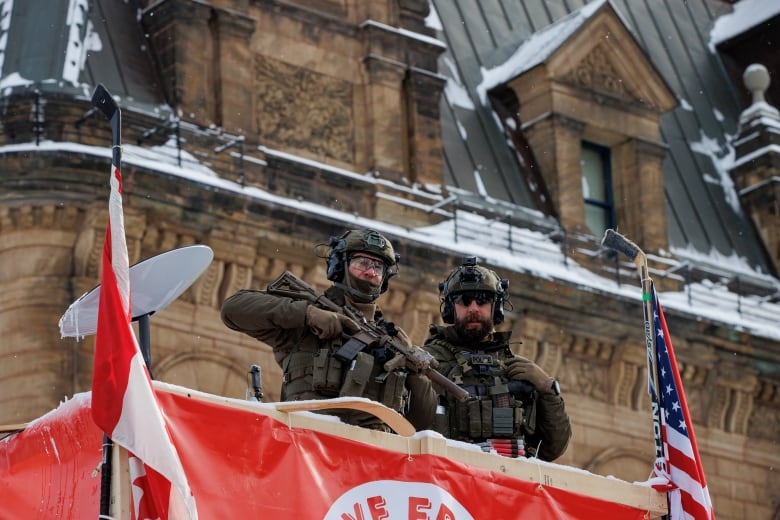
“Clearly, there was an intelligence failure, or there was a failure in acting on the intelligence that was available,” Brown said. “One of the two was in place.”
Bordeleau agreed that police need to step up their intelligence game not only to thwart “traditional” security threats but also to “scrub” social media for open-source information about the mood, motivations and specific intentions of protesters.
“There needed to be a better understanding earlier on of what this could be,” he said.
Negotiations fizzled
The commission has heard a great deal of evidence about the efforts of police liaison teams (PLTs) from both Ottawa police and Ontario Provincial Police to defuse the situation through negotiation.
Those efforts fizzled largely because the PLTs failed to achieve buy-in from all the disparate interest groups involved in the occupation, some of which had no recognizable leader. Others were intractable.
“These are very challenging people to negotiate with,” said Monaghan, who spent many hours among the protesters in the name of academic research. “But I don’t think the police were paying much attention because they’re saying, ‘We can negotiate with these folks.’ Which is terrible advice.”
For similar reasons, negotiating with convoy participants to park in a designated area outside the city core and shuttle downtown to protest was probably a non-starter, Bordeleau added. Better intelligence would have informed police that many of the protesters were in no mood to co-operate.
Monaghan believes police should be more concerned with what he calls the “tactical innovation” he’s witnessed among protesters.
“These groups have gotten stronger and stronger and stronger, they’ve gotten more organized, they have really significant grievances, some are legitimate, some aren’t — and we have no toolbox,” he said. “That doesn’t look great, because they’re going to be innovating and changing, and we’re going to be kind of scratching our heads saying, ‘Why … are you so angry?’ Which is not a great starting point.”
‘These groups will be back’
Police have numerous practical lessons to learn from the convoy protest, including the importance of establishing a cohesive, integrated command structure to handle large demonstrations before they spin out of control. They also need reliable access to a sufficient number of heavy tow trucks so enforcement can begin before it’s too late.
Such measures will require constant vigilance, according to Bordeleau, and a lot of money.
“You’re going to see a bigger investment of resources up front in order to ensure that this doesn’t happen again, and that’s going to be expensive,” he warned.
Adding new powers to police forces or increasing their funding, however, can be controversial — and is much easier said than done, even if it’s required.
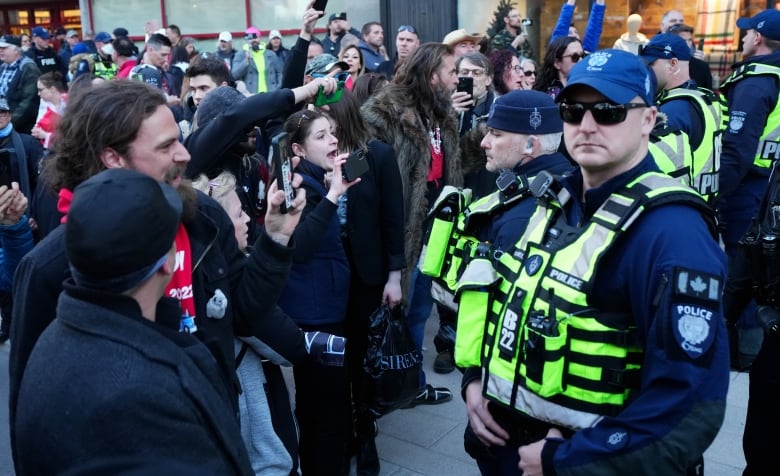
Bordeleau also believes Canada could use protest-specific legislation that’s neither as sweeping nor as heavy-handed as the Emergencies Act, similar to the controversial Public Order Bill in the U.K.
“I think there’s a potential for new legislation to be introduced that helps police and communities deal with these types of demonstrations going forward, to give police the tools up front to deal with this more effectively,” he said.
“These protesters might use different tactics in a different type of protest, and I think police need to be a lot more adaptable.”
Monaghan believes these aggrieved groups have identified Ottawa as a target for their anger. COVID-19 gave them a “great rallying point,” he said, and they will return.
“I think we can count on that,” Monaghan said. “These groups will be back. We just don’t know what shape it will take.”